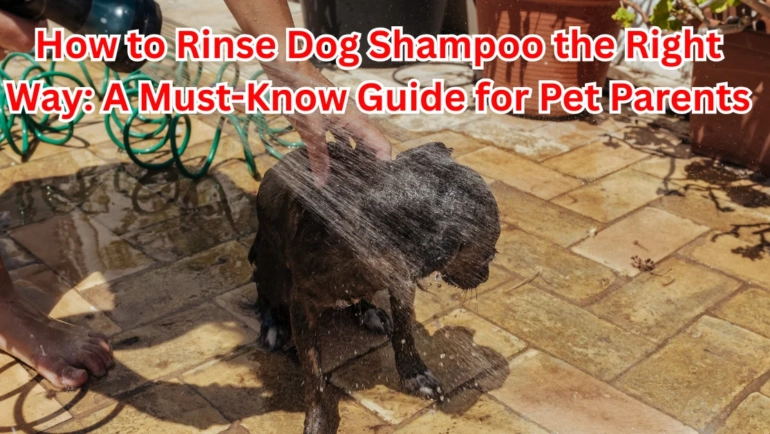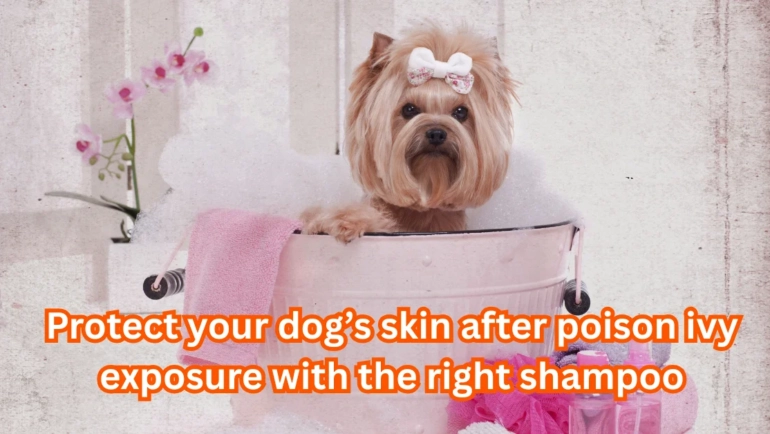
How to Bathe a Dog: 10 Easy Ways to Make Bath Time Easier
As a vet assistant at Ozark Dog Farm, I’ve had my fair share of bath time mishaps; trust me, I’ve learned a lot from them! I’ll never forget the first time I tried to bathe my playful Rumi on my own: halfway through, I was drenched, she was a sudsy whirlwind, and I realised… I was doing it all wrong. If you’ve ever struggled to get your dog clean without turning your bathroom into a splash zone, you’re not alone. Bath time isn’t just about smelling good; it’s about hygiene, skin health, and strengthening your bond.
You’ll find all my best advice here to help you make bath time less messy, more relaxing, and even exciting for you and your four-legged friend.
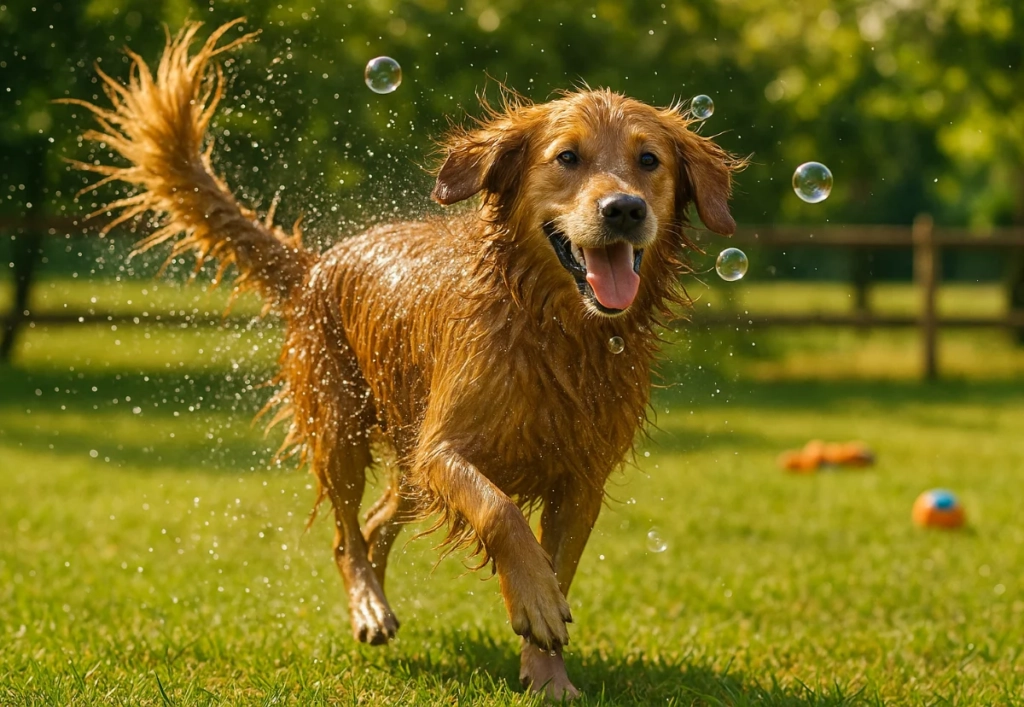
Why Bathing Is Important
Bathing your dog is essential for their health and happiness. It keeps them clean, comfortable, and feeling their best.
Hygiene: Regular baths remove dirt, bacteria, and allergens from your dog’s skin and coat. This is especially important if your dog loves rolling in mud or playing outside like Rumi does on the farm. I once skipped her bath for a few weeks, and she developed some skin irritation. Keeping your dog clean helps prevent infections and promotes their overall health.
Skin Health: Bathing also supports healthy skin. It clears away dead skin cells and boosts circulation. After a bath, Rumi’s thick coat looks shiny, and she seems more energetic. Skipping baths can make dogs scratch, which leads to dry, flaky skin and discomfort.
Smell: Let’s be honest, dogs get into some stinky situations. Bathing removes odours that could linger in your home. Rumi loves to roll in mud after rainstorms. It used to be stressful, but now a good scrub leaves her smelling fresh and clean.
Bonding: Bath time is a special way to connect with your dog. Rumi starts excited and a little chaotic, but as we go through the bath, she relaxes. These moments of gentle care build trust and make bath time a positive experience for both of us.
Preparing for a Dog Bath: The Right Supplies, Spot, and Timing
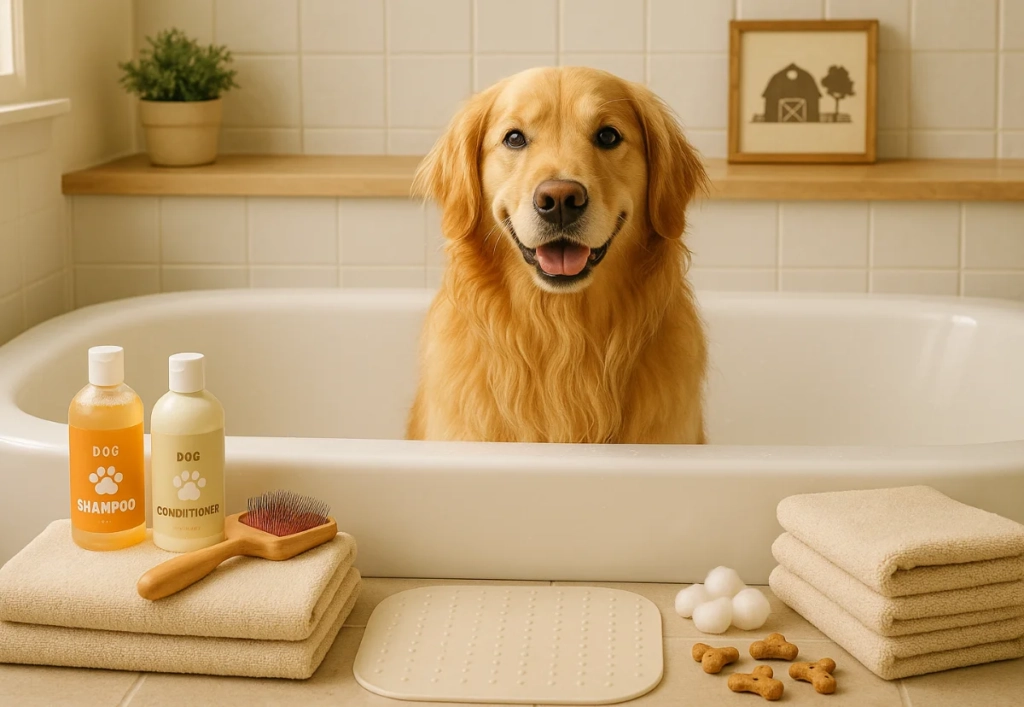
Bathing your dog goes much smoothly when you prepare ahead. I’ve dealt with this first-hand at Ozark Dog Farm. Rumi stares at me with those sad puppy eyes like she’s questioning all my life choices! But once I get everything in place, bath time goes smoother than expected, and honestly becomes pretty fun. Let me tell you what to have ready before you get started.
Supplies Checklist: What You’ll Need
Dog-Specific Shampoo:
Never use human shampoo. It can irritate your dog’s skin. Choose a mild, hypoallergenic shampoo suited for your dog’s coat. I once grabbed the wrong one in a rush, and Rumi broke out in a rash.
Brush:
Always brush your dog before a bath. It removes tangles, loose hair, and prevents mats. For Rumi, a slicker brush works perfectly on her thick, curly coat.
Towels:
Have one or two absorbent towels ready. I always keep an extra for Rumi’s tail, which somehow gets wetter than the rest of her body.
Treats:
Bath time can be stressful. Treats make it more enjoyable and help your dog stay calm. I keep Rumi’s favourites on hand for after the bath.
Cotton Balls:
Protect your dog’s ears by gently placing cotton balls inside. This simple tip prevents water from getting in and reduces the risk of infections.
Non-Slip Mat:
A mat keeps your dog from slipping. I never bathe Rumi without one. She wiggles enough on her own!
Choosing the Right Spot: Where to Bathe Your Dog
Indoor Tub or Sink: Best for small to medium dogs. A detachable shower nozzle makes rinsing easy. I usually bathe Rumi indoors in cold weather. It’s warm, and everything I need is within reach.
Outdoor Hose: Great for larger dogs or water-loving pups. Farm dogs enjoy rinses outside in warm weather. Always check the water temperature first.
Professional Groomer: Some coats or skin conditions require a groomer. Dogs with matted fur or sensitive skin may need extra help. Rumi’s coat is thick but manageable with regular baths at home.
Ideal Water Temperature: Lukewarm water is key, with a temperature range of around 95°F to 100°F. Too hot can burn, too cold can chill. I learned to test it carefully after a few Rumi mishaps. If it’s not right, she lets me know with a very clear stare.
Best Time of Day: Afternoon or early evening works best. Your dog is calmer and more relaxed. I bathe Rumi after her afternoon walk when she’s a little tired. She’s less likely to squirm, though I can’t promise there won’t be a few post-bath zoomies!
With these preparations in place, bath time can be smooth and even fun.
Pre-Bath Grooming: Get Your Dog Ready for a Successful Bath
Bath time becomes way easier when your dog is fully prepped first. I’ve realised the real key isn’t in the bath itself, but in what you do before it. A quick brush, nail check, ear check, and skin inspection make everything smoother and safer. It cuts down the stress and helps your dog stay calm and comfy.
Brush Before or After the Bath?
Always brush your dog before the bath. Wet fur tangles easily, and mats become harder to remove once they’re soaked. I learned this with Rumi. The first time I skipped brushing, I ended up with a soaked, matted mess that took hours to fix. Now, a thorough brushing is always step one. It prevents tangles, reduces shedding, and makes washing much smoother.
Removing Mats and Tangles
For dogs with long or curly coats like Rumi, tackling mats before the bath is crucial. Wet mats are harder to remove and can be painful for your dog. Here’s how I handle it:
Start with a Detangler Spray (Optional): If your dog’s fur is very tangled, a dog-safe detangler spray can help loosen mats.
Use the Right Brush: A slicker brush works well for most long-haired dogs. For thick coats, a de-shedding tool helps. I use a slicker brush on Rumi to get through tangles gently.
Work Gently: Use your fingers or a detangling comb to loosen mats before brushing. If a mat is stubborn, trimming carefully with grooming scissors may be necessary. Always avoid cutting too close to the skin.
Focus on Problem Areas: Mats form easily behind ears, under legs, and around the tail. Spend extra time on these spots to prevent knots.
10 Simple Steps to Give Your Dog a Bath
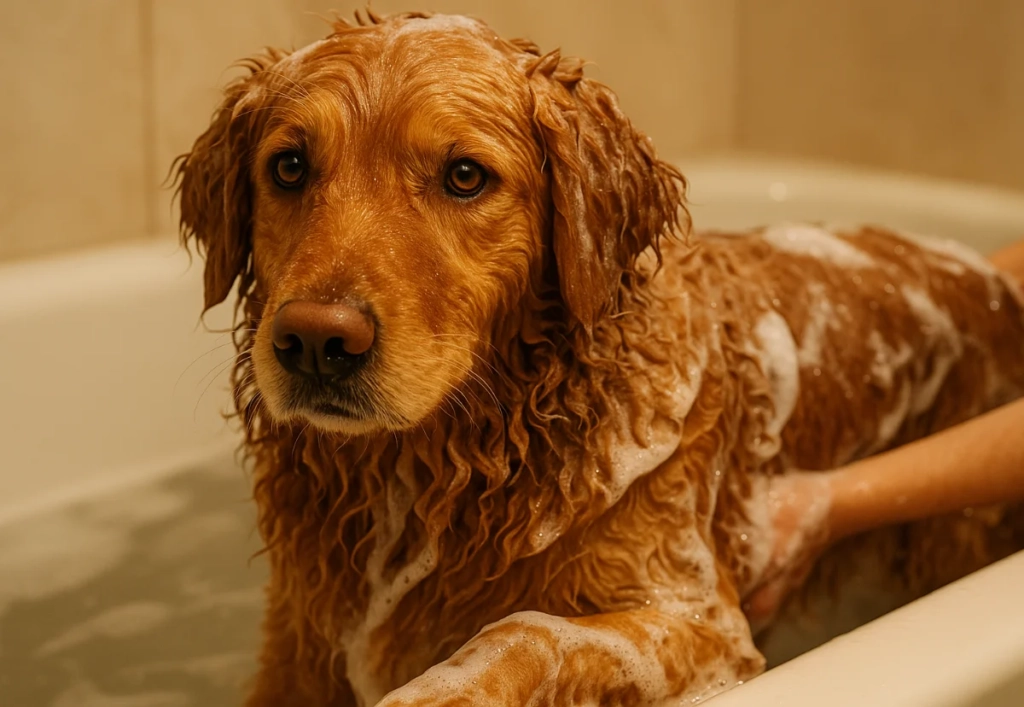
Bathing your dog doesn’t have to be stressful. With the right steps and a little patience, it can be a relaxing experience for both of you. After working with Rumi and countless farm dogs, I’ve developed a method that keeps bath time smooth, safe, and even fun. Here’s how to do it.
Step 1: Secure and Calm Your Dog
Before turning on the water, secure your dog in place. Small dogs do well in a sink or tub. For larger dogs, a bathtub or shower with a non-slip mat works best. Rumi is a little wild, so I gently leash her to the faucet to prevent her from jumping out.
Take a few moments to calm your dog. Talk softly and pet them gently. Giving a treat at this stage can also help set a positive tone. This is especially important if your dog is nervous about water.
Step 2: Protect Ears with Cotton
Dogs with floppy ears are prone to ear infections from water. Gently place cotton balls in their ears before bathing. This keeps water out and protects their inner ear.
Step 3: Wet Thoroughly, Avoid Eyes and Ears
Use lukewarm water to wet your dog’s coat evenly. Avoid eyes and ears. Start from the back and work toward the front. Rumi loves to shake her head as soon as water hits, so go slowly to avoid getting soaked yourself.
Step 4: Apply Dog-Safe Shampoo
Always use dog-specific shampoo. Human shampoo can irritate their skin. Apply a generous amount to the back and chest, working it into a gentle lather.
Step 5: Lather and Massage the Coat
Massage the shampoo into the fur, focusing on areas with the most dirt, such as the paws, belly, and tail. Avoid the face. Gentle massaging relaxes your dog and ensures a thorough clean.
Step 6: Rinse Thoroughly
Rinse completely to remove all shampoo. Leftover residue can cause itching and irritation. I always double-check Rumi’s coat to make sure no suds remain.
Step 7: Apply Conditioner (Optional)
If your dog has dry or long fur, use a dog-safe conditioner. Massage it into the ends of the coat and then rinse thoroughly. I use a conditioner in winter when her fur tends to dry out. Short-haired dogs may not need this step.
Step 8: Final Rinse and Remove Cotton
Rinse off all conditioners completely. Carefully remove the cotton balls from your dog’s ears. Make sure no water is trapped inside.
Step 9: Dry Your Dog
Pat your dog with a soft, absorbent towel to remove most of the water. You can also use a blow dryer on a low, cool setting if your dog is comfortable with noise. Never use hot air. Rumi gets nervous with the dryer, so I mostly rely on towels. Make sure your dog isn’t left wet too long, especially in cold weather.
Step 10: Reward and Brush Again
Once dry, give your dog a treat and lots of love. Rumi always enjoys a hug and praise after her bath. After they’re calm, brush their coat one more time to smooth out any tangles. This keeps them looking and feeling great.
Bath time may take effort, but following these steps makes it a stress-free experience. Be patient, go slow, and reward your dog for good behaviour. Happy bathing!
Aftercare & Grooming Post-Bath: Keeping Your Dog Looking and Feeling Great
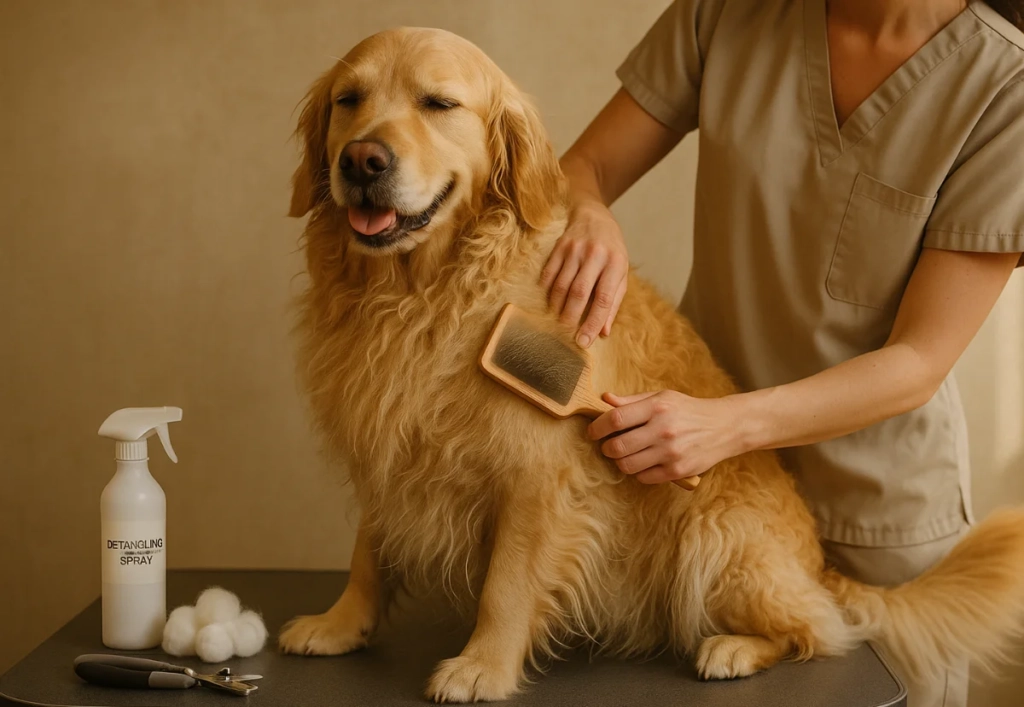
The bath might be over, but your work isn’t finished. From my time as a vet assistant, I know that post-bath care is huge for your dog’s wellness. With Rumi, I always give her coat, nails, paws, and ears extra attention once she’s clean. Here’s the routine you should follow afterwards.
Detangling Sprays: Keep That Coat Smooth
If your dog has long or curly fur like Rumi, a detangling spray can be a lifesaver. It prevents knots and makes brushing easier. I lightly mist Rumi’s damp coat and gently comb through her fur, especially around sensitive areas like her ears and belly. This keeps her coat soft, shiny, and tangle-free.
Nail Trimming, Ear Cleaning, and Paw Care
Once your dog is dry, it’s a great time to tackle other grooming tasks.
Nail Trimming: Bath time makes nails softer and easier to trim. If your dog doesn’t love nail trims, go slow. Use a proper trimmer or grinder and file any sharp edges. When in doubt, ask your vet or groomer for guidance.
Ear Cleaning: Check your dog’s ears to ensure no water is trapped inside. Moisture can lead to infections, especially in floppy-eared dogs. Gently wipe the outer ear with a damp cloth or dog-safe cleaner. Cotton balls work well, just don’t push them too deep. Redness or odour? Consult your vet.
Paw Care: Dry and inspect the paws carefully. Look between pads for dirt, small stones, or cuts. I always check Rumi’s paws after walks to prevent irritation or infection.
Brushing Again to Reduce Shedding
Once your dog is completely dry, give their coat another brush. Bathing loosens dead hair, and brushing removes shedding fur while keeping the coat smooth and healthy. I use a slicker brush or de-shedding tool on Rumi to get through her thick layers. Brushing also distributes natural oils, leaving her coat glossy and soft. Regular post-bath brushing keeps her looking great and reduces hair around the house.
Keeping Your Dog Calm During Baths: Tips and Tricks for a Stress-Free Experience
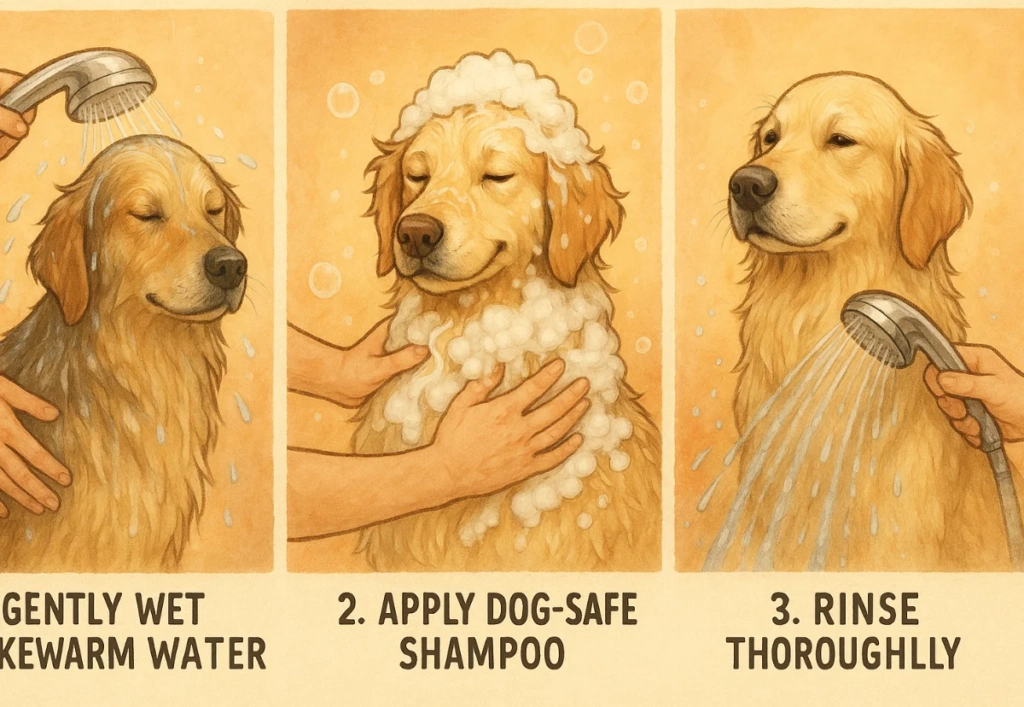
Bath time can be stress-free for both you and your dog. With patience and the right approach, even nervous pups can learn to enjoy it. As a vet assistant at Ozark Dog Farm, I’ve seen many dogs go from anxious to relaxed with a few simple strategies. Rumi was nervous at first, but through calm routines and positive reinforcement, she now tolerates bath time, and sometimes even enjoys it. Here’s how to keep your dog calm and comfortable.
Positive Reinforcement with Treats:
Treats are one of the easiest ways to make bath time positive. Dogs quickly learn to associate the experience with rewards.
Before the bath: Give a treat when your dog enters the bath area calmly. This sets the tone for a good experience.
During the bath: Offer small treats at key points, like after wetting the fur, applying shampoo, or rinsing. This keeps your dog focused and relaxed.
After the bath: Reward your dog when the bath is done. A special treat or extra praise reinforces that bath time ends positively.
Toys, Slow Introduction, and Creating a Calm Environment
For anxious dogs, distractions and gradual exposure help.
Toys: Some dogs enjoy having a bath-only toy to play with. I give Rumi a durable rubber toy to keep her distracted.
Slow introduction: Let your dog explore the bath area before using water. Rumi could jump in and out of the tub on her own before her first full bath. This reduces anxiety and builds familiarity.
Calm environment: Keep the area quiet and organised. Avoid loud noises or sudden movements. Speak in a soothing voice and stay relaxed; dogs sense your emotions.
Bath Training for Puppies vs. Adult Dogs
Different ages require different approaches.
Puppy Bath Training: Puppies are more adaptable and benefit from early exposure. Short, gentle baths with praise and treats make the experience positive. Keep a routine so your puppy becomes familiar with the process. Positive reinforcement is key.
Adult Dog Bath Training: Adult dogs may have learned fear from past experiences. Gradual exposure is important. Start by letting them explore the bath area and rewarding calm behaviour. Patience and consistency help build trust. Go at their pace and use a calm, reassuring approach.
Bath time doesn’t have to be stressful. With treats, patience, and a calm environment, even the most nervous dogs can learn to enjoy, or at least tolerate, their baths.
Common Mistakes to Avoid When Bathing a Dog
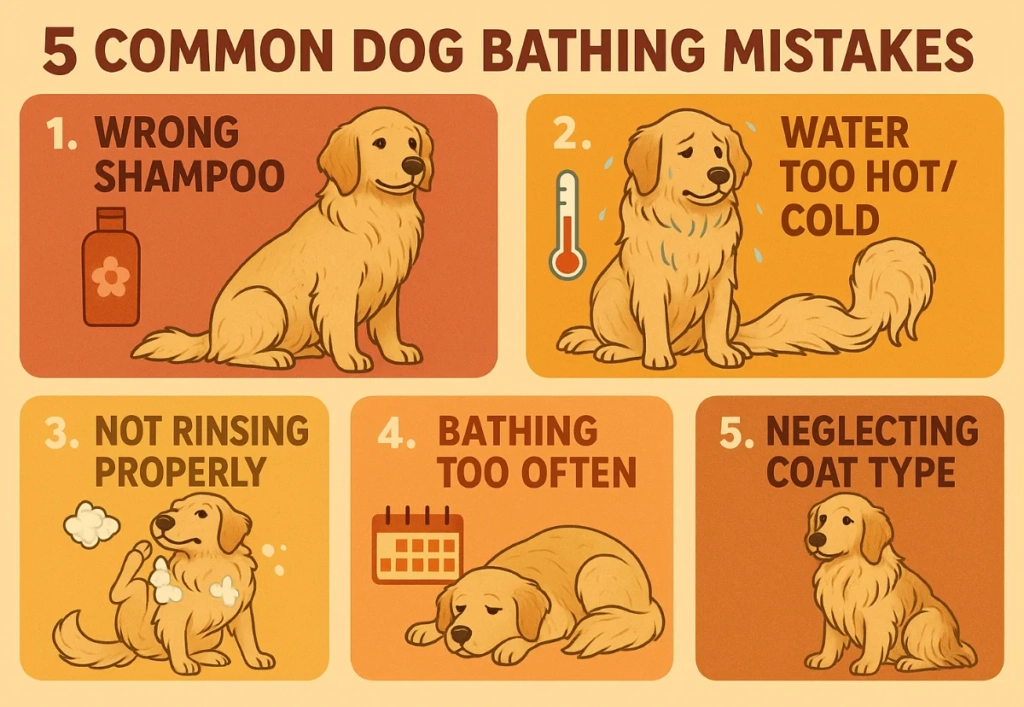
Bath time can feel overwhelming, especially if you’re new to it. But with a little know-how, it can be smooth and even enjoyable. After working with Rumi and countless farm dogs, I’ve learned some mistakes that make baths harder than they need to be. Avoid these to keep your dog happy and healthy.
Using the Wrong Shampoo
Never use human shampoo on dogs. Our shampoos are made for our skin, not theirs, and can cause irritation, dryness, or allergic reactions. I once grabbed my shampoo by mistake, and Rumi developed a rash within hours. Always choose a dog-specific shampoo that’s gentle and pH-balanced.
Be careful with medicated or flea shampoos, too. These are meant for specific conditions, like skin infections or flea infestations. Using them unnecessarily can dry out or irritate your dog’s coat. Always follow your vet’s guidance.
Using Water That’s Too Hot or Cold
Dogs have sensitive skin, so water temperature matters. Too hot can burn, too cold can make them shiver. Lukewarm water, around 95°F to 100°F, works best. I always test it with my wrist or elbow. Rumi isn’t shy about letting me know if it’s uncomfortable.
Not Rinsing Properly
Rinsing thoroughly is crucial. Shampoo left on the skin can cause itching, dryness, or rashes. Always rinse all areas, including the neck, underarms, and tail. I run my hand through Rumi’s coat to make sure no suds remain.
Bathing Too Often
Overbathing can strip natural oils, leading to dry, flaky skin. Most dogs do fine with a bath every 4–6 weeks. If your dog isn’t dirty or smelly, stick to regular brushing instead. Avoid weekly baths unless your vet advises it.
Special Cases & Alternatives for Bathing
Not all dogs are the same. Some may need adjustments to their bathing routine.
Bathing Different Coat Types
Short Coat Dogs: Breeds like Beagles or Boxers need fewer baths, usually every 6–8 weeks. Regular brushing helps manage shedding.
Long Coat Dogs: Breeds like Shih Tzus or Collies need more frequent baths to prevent tangles. Brushing after every bath is essential.
Double Coat Dogs: Huskies or Golden Retrievers have dense undercoats. Bathing too often can interfere with shedding and coat health. Every 4–6 weeks works best.
Sensitive Skin Breeds: Bulldogs or some terriers may require special shampoos for their skin. Always check with your vet before bathing dogs with skin conditions.
Dogs with Allergies or Skin Conditions
If your dog has allergies or skin conditions, you might need to adjust your bathing routine. Medicated shampoos can help with specific conditions like fungal infections, dry skin, or hot spots. Always consult your vet to determine the right products for your dog. Also, avoid using scented shampoos, as fragrances can irritate sensitive skin.
Alternatives When Full Baths Aren’t Possible
Sometimes, full baths aren’t feasible or necessary. In those cases, there are a few alternatives:
- Dry Shampoo: Dry shampoos are a great option if your dog needs a quick refresh but doesn’t need a full bath. They’re easy to use and can be particularly helpful for dogs that are anxious about water.
- Dog Wipes: If your dog is dirty but doesn’t need a full bath, dog wipes can be a quick and effective solution. They’re especially handy for wiping down your dog’s paws, face, and underbelly.
Professional Grooming vs. DIY
Professional grooming is always an option for dogs that need extra attention, especially for breeds that require specialised cuts or trims. If you’re not comfortable bathing your dog yourself, a groomer can handle the task for you. However, regular DIY baths at home are completely fine as long as you follow the right steps and use the proper tools.
FAQs: Your Dog Bathing Questions Answered
What is the proper way to wash a dog?
Brush the coat, wet with lukewarm water, apply dog-safe shampoo, lather gently, rinse thoroughly, optionally apply conditioner, rinse again, and dry with a towel or blow dryer.
Do dogs feel better after a bath?
Yes. Baths remove dirt, allergens, and debris, making dogs more comfortable. A positive bath can also be relaxing.
How long can dogs go without a bath?
Most dogs go 4–6 weeks, but it depends on breed, activity, and coat type. Outdoor dogs may need more frequent baths.
How do I know when my dog needs a bath?
Signs include odour, oily or dirty fur, or visible dirt. Rolling in mud or other messy things is a clear cue. Adjust your schedule as needed.
A Happy Ending to Bath Time
Bath time doesn’t have to be a battle. With a bit of prep and a calm mindset, it can become one of the sweetest bonding times you share with your dog. Every dog has different needs, so take note of their comfort level, brush them properly, rinse well, and praise them often. Thanks to Rumi, I’ve learned that even the most energetic dogs can enjoy a bath when you keep it positive and calm. These simple tips can turn bath time from stressful to special. Be patient, stay gentle, and enjoy every small success. Your dog will reward you with cuddles and a fresh, clean coat.


